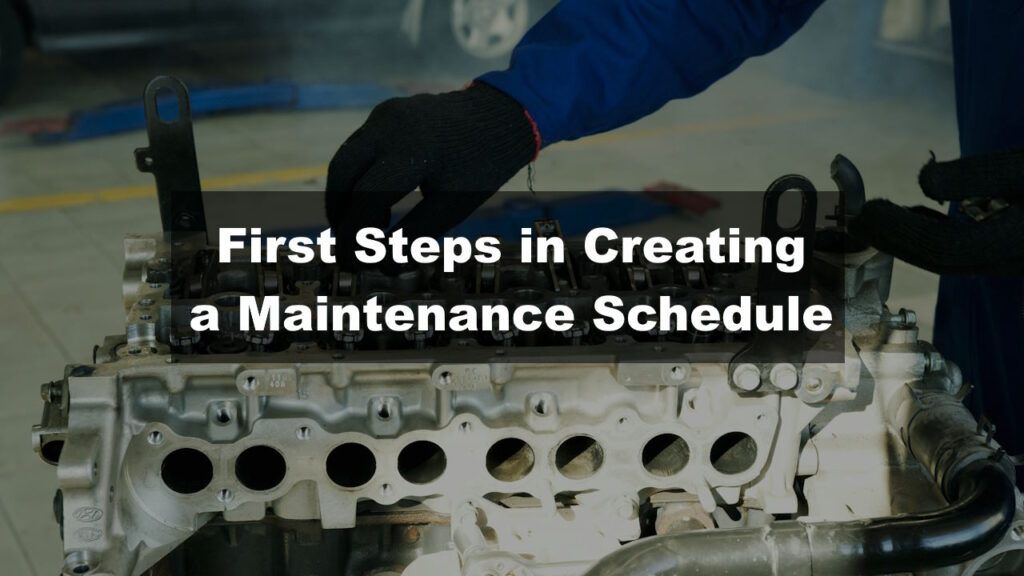When managing plant and equipment, a crucial aspect stands out: the maintenance schedule.
Creating an effective maintenance schedule is essential for ensuring equipment reliability, enhancing safety, and minimizing downtime.
But where do we start?
Let’s explore the first step in developing a robust maintenance schedule.
Understanding Your Assets
The first step is taking stock of your assets. This stage involves identifying all equipment, machinery, vehicles, and other critical components within your organization.
Comprehensive Inventory
Begin by compiling a detailed list of your assets. This list should include:
- Type of equipment
- Model numbers
- Serial numbers
- Locations
The more detailed this inventory, the easier it will be to track maintenance tasks later.
Visualization helps here—consider creating an easy-to-read asset register. This could be as straightforward as an Excel spreadsheet or a dedicated database.
Assessing Criticality
After detailing your assets, think about their criticality to your operations.
Some equipment might be essential for day-to-day functions, while others may be less crucial. Classifying your assets based on importance helps prioritize maintenance tasks. For instance, if a critical piece of machinery fails, it can cause significant operational disruptions and financial losses.
Understanding each asset’s role allows for a more strategic allocation of maintenance efforts.
Assessing Maintenance Requirements
Once you have a clear inventory, focus on understanding the specific maintenance needs of each asset. Equipment comes with manufacturer recommendations regarding maintenance frequency and requirements—these documents are key references.
For example:
- Engines may need oil changes every 5,000 miles.
- HVAC systems might require seasonal checks.
Conducting Regular Inspections
Establish a regular routine for inspecting equipment, perhaps monthly or quarterly.
During these inspections, note any unusual wear or changes in performance. Gathering input from operators and maintenance personnel can also provide valuable insights, as they often notice when equipment isn’t functioning properly.
Compliance Considerations
Don’t forget to look at industry standards and regulations relevant to your sector.
Compliance with health and safety standards may dictate specific maintenance practices, particularly in industries like construction and manufacturing. Understanding these requirements ensures that you’re not just keeping equipment running smoothly, but also adhering to legal standards that protect employees and the environment.
Defining Maintenance Types
Next, consider the different types of maintenance required for each asset. Maintenance generally falls into four main categories:
| Type of Maintenance | Description | Examples |
|---|---|---|
| Preventive | Regularly scheduled inspections and tasks | Oil changes, filter replacements |
| Predictive | Data-driven predictions about maintenance needs | Vibration analysis, thermal imaging |
| Corrective | Repairs made after equipment failure | Replacing a damaged part, emergency repairs |
| Condition-based | Maintenance based on actual equipment conditions | Monitoring wear and tear indicators |
Understanding these categories is vital for crafting a suitable maintenance schedule that meets both operational and compliance needs.
Involving the Team
Creating a maintenance schedule isn’t a solo endeavor. Engaging with everyone who interacts with the equipment can enhance the accuracy and effectiveness of the plan.
This collaborative approach fosters accountability and increases maintenance efficiency.
Cross-Functional Meetings
Gather a cross-functional team that includes operators, maintenance personnel, and management.
Brainstorming sessions can lead to fruitful discussions about best practices and historical challenges related to equipment maintenance. Each team member may bring unique experiences that inform the schedule, helping to spot potential issues early.
Training Opportunities
Utilizing training opportunities helps keep your team updated with the latest knowledge on maintenance practices and technologies.
Ensuring everyone is informed about equipment standards and protocols contributes to more effective and compliant maintenance activities.
Designing the Schedule
Now comes the exciting part: assembling the maintenance schedule! The information collected will guide you in creating a structured maintenance timeline.
Frequency of Maintenance
Start by determining how often each category of maintenance should occur based on factors like asset type, criticality, and maintenance type.
For preventive maintenance, many organizations opt for a calendar-format approach, allowing you to assign specific dates to maintenance tasks.
This can be managed with dedicated software or a shared online calendar that provides easy updates and notifications.
Incorporating Predictive Maintenance
For predictive and condition-based maintenance, weave these into the schedule based on analytics capabilities.
For example, if sensors indicate increased equipment vibration, this can prompt immediate inspection in your maintenance calendar.
Workflow Considerations
As you design the schedule, be mindful of how it fits into your operation workflow.
Avoid scheduling heavy maintenance during peak production times to minimize disruptions. Communicating with affected teams about upcoming maintenance ensures everyone is prepared for any necessary adjustments.
Monitoring and Adjusting the Schedule
Creating a maintenance schedule isn’t a one-time task—it’s crucial to continually monitor its effectiveness and adjust as necessary.
Regular Reviews
Set up regular reviews of maintenance performance to evaluate whether tasks are completed on time and achieve expected results.
Maintaining detailed logs is essential for analyzing patterns over time, such as frequent repairs indicating that preventive measures may need adjustment.
Collecting Feedback
Solicit ongoing feedback from team members about what’s working and what might need improvement.
This collaboration nurtures a culture of continuous improvement.
Conclusion: Moving Forward
Creating a maintenance schedule can seem daunting, but breaking it down into manageable steps establishes an effective framework for keeping your assets in optimal condition.
Starting with a thorough inventory, assessing maintenance needs, defining types of maintenance, involving your team, creating a structured schedule, and monitoring performance will lead to success.
By ensuring that your maintenance practices are proactive, you enhance operational efficiency, compliance, and safety. This approach supports the overall goals of your organization.
Know This: Regular preventive maintenance can extend the life of equipment by 20% to 40%, saving on replacement costs and minimizing potential downtime.
Pro Tip: Consider using maintenance management software to streamline scheduling, automate reminders, and track maintenance activities efficiently.
With these principles and strategies in mind, you’re well-equipped to develop an effective maintenance schedule that keeps your operations running smoothly!
